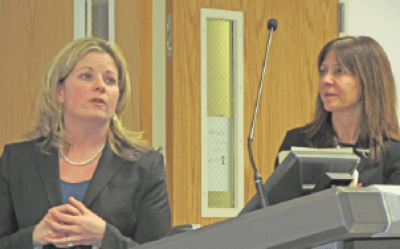The East Williston School District administration presented a preliminary 2013-14 budget of $54.38 million at last Wednesday night’s East Williston school board meeting that calls for the elimination nine positions including two teachers to stay under the state-mandated tax cap.
“It was all done by maintaining programs and not increasing class size,” said East Williston Board of Education President Mark Kamberg, who praised the administrators for their efforts.
The proposed budget represents a 3.15 percent increase over the district’s current $52.72 million budget. Under the proposal, the tax levy would rise 3.23 percent to $50.97 million from the current $49.38 million level.
Kamberg commended district unions, particularly the district teachers association, for helping the district hold down costs.
The teachers association agreed to a four-year contract in 2011 that will hold their salaries to an average 1.1 percent increase over the duration of the deal. The agreement called for the teachers to accept a wage freeze in the first year of the contract, and a freeze on step increases for the first two years of the contract.
Jacqueline Fitzpatrick, district assistant superintendent of business, said a reduction in the nine positions would represent a savings of approximately $800,000 in salary and benefits. Shifting and reducing staff responsibilities would produce a savings of $300,000, she said. Fitzpatrick said cuts of more than $700,000 from building budget and supplies along with the reductions in personnel will enable the district save $1.8 to $2 million needed to stay within the state-mandated tax cap without eliminating any programs. In addition to two teaching positions, the budget calls for the elimination of five teaching assistants, a custodian and an audio-visual clerical position.
“If we were to do nothing different, we would have to spend $1.8 million to $2 million, which we cannot do,” said East Williston Superintendent of Schools Elaine Kanas.
Kanas said curriculum associates in grades K through 12 who previously taught one period with four free periods daily would now teach three classes and serve as secondary department chairs. One technology teacher position would also be eliminated, with that teacher’s role assumed by a district administrator and other technology personnel. A reading readiness teaching position at the North Side School would also be eliminated. Remaining teaching assistants would provide the classroom coverage for the five eliminated positions.
Fitzpatrick said after the meeting that eliminating the five teaching assistant positions would save the district approximately $270,000. The elimination of the technology teacher position, she said, would save $140,000 and the shift in curriculum associates teaching more classes would eliminate the equivalent of a staff position.
“Every student who requires teaching assistance will be receiving it,” Kanas said.
The Lincoln Center program, a BOCES program at the elementary and middle school, would be eliminated and middle school athletic teams would field one team in sports where there are now two. Intramural teams would be organized to enable all students to participate in team sports, Kanas said.
Kanas said the district would also cut $50,000 from staff development programs.
One district maintenance worker position would be eliminated and each district school library will now have one audio visual aide. The Wheatley School currently has two audio visual aides.
“We focused on realizing and matching our resources to meet the needs of the students,” Kanas said.
During the meeting, Fitzpatrick said the big budget drivers are pension costs with Teachers’ Retirement System costs projected to rise 33.27 percent to more than $4 million and the Employees Retirement System costs projected to rise by 44.75 percent to $513,893.
“These are high costs,” Fitzpatrick said. “These costs keep driving up in record numbers.”
Kamberg said district residents should join in the school board’s lobbying efforts with local state legislators to provide the school district with relief from rising costs mandated by the state.
“They were very quick to put the cap in place, but they haven’t acted on mandate relief,” Kamberg said.
Stephan Leccesse, a member of the district financial advisory board, said the district has been paying increases on employee benefits averaging 5 percent a year over the past several years. He said benefits costs need to be addressed with the respective employee unions.
“What we have right now is structurally not sustainable,” Leccesse said.
Fitzpatrick said the district’s tax certiorai payments were tentatively set at $50,000 to make up the shortfall from tax appeals.
The county is not currently covering those costs after abandoning the county guarantee. A state judge ruled last week against the county’s decision to abandon the guarantee. County officials said they would challenge the court ruling.
Fitzpatrick said the district’s costs related to the new state-mandated Annual Professional Performance Review would be $83,250.
Kamberg slammed the tax certiorari obligation, saying, “This is an embarrassment and a disgrace. This is a direct shift onto the backs of the our children.”
Fitzpatrick also made a presentation on the administrative and capital costs called for under the proposed budget.
The budgets calls for an 11 percent increase in administrative costs to $5.78 million in 2013-14. Included in the total is school administrators’ salaries and benefits, data processing, public information and legal fees.
The capital component of the administrative budget would rise 12 percent to $6.4 million. It is comprised of debt service on buildings and leasing costs, utilities, service contracts and maintenance supplies and equipment.
Fitzpatrick said the proposed business administration budget calls for a $29,185 increase and the school board budget to decrease by $3,150 year-to-year.

